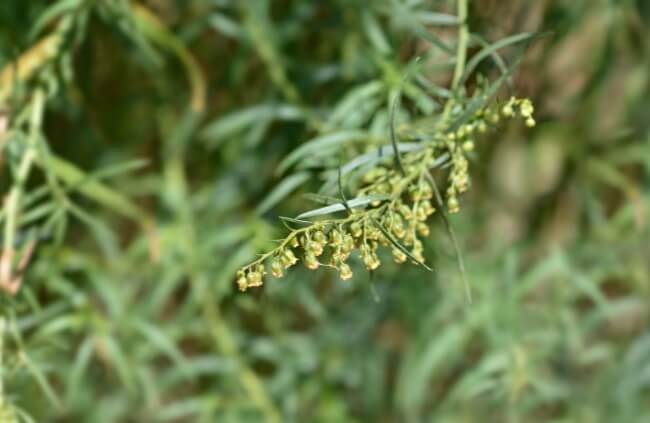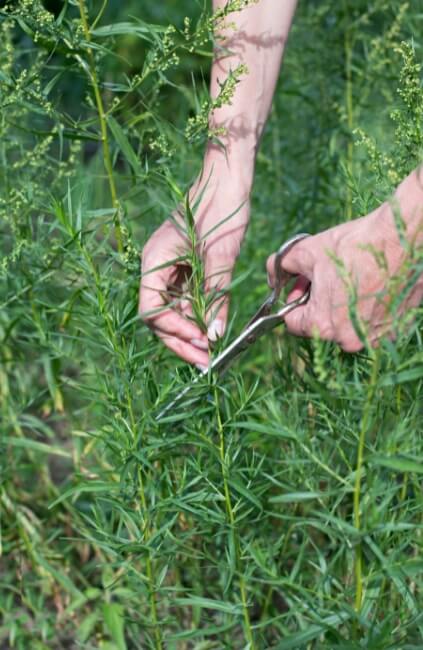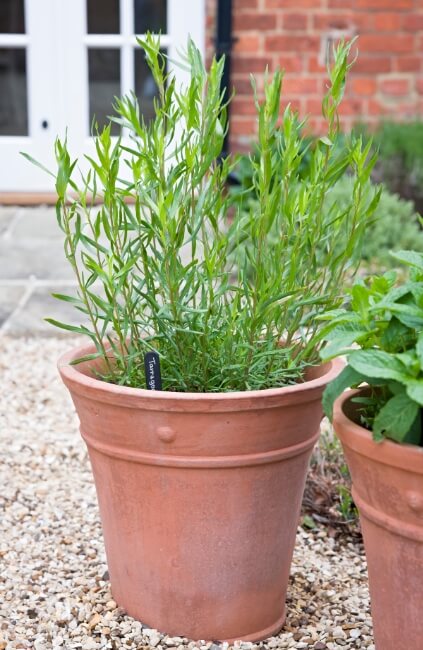Tarragon’s signature flavour makes it a staple in traditional bearnaise sauce, adding that zingy, liquorice kick to a smooth and creamy base. But this undemanding herb can often be overlooked for more popular alternatives due to its particular and dynamic flavour profile, which has given it a reputation as an acquired taste.
However, tarragon is worth its weight in your garden and we will show you just how to grow this one-of-a-kind herb and how to identify it. A little goes a long way with tarragon and you’ll have fabulously flavoured, fragrant, fresh leaves right at your barely lifted fingertips!
More...

Family: | Asteraceae |
|---|---|
Genus: | Artemisia |
Species: | A. dracunculus |
Common names: | French Tarragon, Russian Tarragon, Estragon, Biting Dragon, Little Dragon |
Origin: | Europe, Asia, Russia |
Location: | Outdoor/indoor |
Type: | Deciduous perennial, edible herb |
Growth: | Up to 1.5m tall |
Sun requirements: | Full sun |
Foliage colour: | Green |
Flower colour: | Orange to Yellow |
Flowering: | Summer |
Edible parts: | Leaves are used as a herb |
Maintenance level: | Low |
Poisonous for pets: | Toxic to pets |
What is Tarragon?
Tarragon is a well-loved and unique herb that has been and remains a part of many different cultural cuisines. The name tarragon comes from the French ‘estragon’ meaning little dragon, possibly inspired by the coiled, serpent-like roots resembling traditional Chinese dragons.
Identifying Tarragon
French tarragon can grow up to around 3ft tall and very rarely ever produces seed so is only available to purchase as plants. Be wary of seeds available labelled as French as it’s likely to be Russian tarragon.
Flower Identification
All tarragons flower, but if you’re looking for a tarragon to add colour and interest then the French one may not satisfy as it barely flowers, and rarely at that.
French tarragon flowers are small, and resemble more of an unopened bud than a flower. They are pale green or cream, held on spires and have a delicacy in their own gentle way. They very rarely flower, and the seeds they produce are sterile.
The bright yellow and orange, cheerful flowers of the Russian and Mexican tarragon are very similar, both somewhat marigold-like, simple, open and beneficial for pollinators.

Leaf Identification
French tarragon has a distinctive, narrow and slightly twisted leaf shape. Tarragon leaves are lanceolate and typically around 1-3 inches long, as a whole the plant could be initially mistaken for a rosemary.
Russian tarragon has spikier leaves and is less glossy than the French and may have a more upright form but generally, both look very similar and it can be difficult to identify without taste testing. Comparatively speaking, Artemisia dracunculus var. sativa, the French herb has a sweeter and more pleasing flavour. Older Russian tarragon tends to lose its flavour considerably.
The Mexican tarragon has that distinctive anise scent with lanceolate to oblong leaves around 3 inches long. It has a varying habit with some plants growing more upright and others more sprawling and loose.
French Vs Russian Tarragon
Generally, when chefs turn to tarragon for cooking purposes, French tarragon (Artemisia dracunculus var. sativa) is head and shoulders above its relative Russian alternative (Artemisia dracunculoides Pursch). The French variety is finer leaved with more anise flavour. This is created by the naturally occurring compound estragole which also gives fennel its distinctive flavour.
Both plants are true tarragon and share similar attributes but Russian tarragon is said to be a lot less flavourful alongside producing coarser, thicker leaves which are thought of as inferior for culinary uses.
However, where French tarragon excels in flavour, it lacks in reliability to grow as it’s often described as short-lived and temperamental. The Russian herb is a better all-round grower in different climates.
Alongside these two well-known varieties of tarragon, there is a Mexican alternative masquerading as tarragon known as Tagetes lucida. Although Mexican tarragon is technically a Tagetes and belongs to the Marigold family, it is often used as a tarragon due to its anise, tarragon-like, leaf.


Get Your Free Guide:
Master Growing Australian Natives eBook
A Must Have Complete Guide for Every Australian Garden
Get Your Free Guide:
Master Growing Australian Natives eBook
A Must Have Complete Guide for Every Australian Garden
What is Tarragon’s Natural Habitat?
Artemisia dracunculus grows naturally across Europe, Asia and North America and is commonly referred to as wild tarragon. Wild tarragon is a polymorphic species that grows in temperate climates and produces viable seed which is successfully spread across these continents. However, this species is not normally cultivated for food as its flavour can be very variable and inconsistent.
The culinary variety ‘Sativa’ is bred from this wild tarragon but is less hardy and can succumb under cold wet winters.
Common Uses of Tarragon
We know that tarragon is often found growing in herb gardens, but tarragon's first use was medicinal, and it was used to treat a whole plethora of ailments.
Medicinal and Cosmetic Uses
Tarragon has also infiltrated the cosmetic industry proving itself a valuable resource. In oil form, it is considered to be a soothing and cleansing treatment that brings positivity and calm to your mind. Its general antioxidant and antibacterial properties see it being incorporated into more and more natural products.
Folklore suggests that it was used to treat snake bites, insect stings and maybe less often, bites from rabid dogs. In Ancient Greece, tarragon was believed to be used as an anaesthetic due to its content of Eugenol, a naturally occurring chemical present in the leaf.
Edible Uses
Tarragon tea features in several cultures, the French believe that the steeped leaves can treat insomnia and hyperactivity. Alongside this, tarragon is often preserved in vinegar and used to treat a host of digestive problems.
Besides tarragon’s important role in traditional Bearnaise sauce, its unique flavour profile perfectly lends itself to cocktails adding depth of flavour.
How to Grow Tarragon in Australia
Tarragon is very easy to grow and take care of. Knowing what you want to gain from the herb will help you decide which variety to grow and how best you can grow it.
How to Propagate Tarragon
Seed growing tarragon is only suitable for Russian and Mexican varieties as they produce viable seed, commercially available to buy and grow. French tarragon generally doesn’t produce seed and if it does they will indefinitely be sterile.
Growing tarragon from cuttings and division is a more reliable form of propagation. Notes on both methods follow.

Propagating Tarragon from Cuttings
- Use a sharp and sterile pair of scissors or cutting knife and cut a length of around 4-6 inches just under a node.
- Carefully strip away the lower leaves, leaving the top few sets.
- Insert the cuttings into a free draining peat-free potting mix, making sure a few nodes are below the soil.
- Water your cuttings well and leave them in a sheltered spot where they will receive regular watering and dappled sun.
- Cuttings should start to produce roots in a few weeks.
Tarragon Propagation from Division
To be able to divide a tarragon into new plants to grow on, you need a healthy specimen mother plant. Division is straightforward.
- Carefully tease apart the plant into individual plants. You will notice the thick rhizomatous roots which will help you tease apart what you can.
- If any roots fall off, these can also be planted, as even very small pieces of rhizomatous root can regrow.
- These individual plants can be repotted into peat-free compost and grown on.
- Any pieces of small root can be potted into small pots and kept growing under shelter.
Ideal Conditions for Planting Tarragon
To get the best from tarragon, grow it in light and free-draining soil, preferably neutral to alkaline. If it lacks nutrients then all the better as tarragon can thrive in impoverished ground.
Tarragon prefers a sunny location and will grow best in a bright and warm environment, but some shaded protection may be needed in hot or tropical conditions.
If you are growing French tarragon in a colder climate, you may need to give your plant some shelter through winter. French tarragon isn’t hardy and can be killed by any frosts, so consider planting in a pot that can be moved if necessary.
Mexican and Russian tarragon are much hardier and won’t need any shelter from cold weather.
How to Plant Tarragon
To prepare your ground for planting tarragon, check your soil structure as any poorly drained areas will create an inhospitable environment for your tarragon.
Dig in extra grit or stone which will aid drainage and avoid any root rot. Tarragon’s thick rhizomatous roots want to spread through loose soil and won’t tolerate any clay or moisture-laden ground.
How to Care for Tarragon

Generally, very little care is needed for tarragon to thrive. However, following a few simple care tips for each type can ensure a healthy and productive plant. For example, tarragon requires no watering after the plant has established in your garden. It is drought tolerant.
There is also no need to feed tarragon, as it actually tastes better when grown on poor soil. On exceptionally depleted soil, where tarragon plants are yellowing, provide a light liquid feed once or twice throughout the growing season.
Pruning Tarragon
Harvest your tarragon leaves regularly as this will be the best pruning your plant can have. Regular picking encourages new growth and keeps the plant bushy.
When the season ends and your tarragon starts to die back for the winter, cut it back to the ground. It can be useful to mark the area with a sign or set of bamboo canes to remind you where your tarragon is planted and avoid any accidental disturbance.
Repotting Tarragon
Growing tarragon in pots or containers is a perfect way to control your herb's environment for the best possible results. This way you can add sufficient drainage and move your plant when it needs extra sun or shelter.
However, it is important to note that French tarragon can be short-lived, and will benefit from lifting and dividing every 3 to 4 years.
To repot tarragon:
- Divide the root ball in half.
- Remove any old woody roots.
- Re-plant each half into a gritty, free-draining mix.
- Bonus: Plant the woody roots you removed into a similar mix to create new plants for next year.
Harvesting & Storing Tarragon
Tarragon does not store well once picked, so pick only what you need just before using it to ensure the leaves stay fresh and full of flavour. You can preserve tarragon by adding it to vinegars and oils giving beautifully infused dressings.
You can also dry your tarragon leaves for future use. By spreading out your cuttings onto a dry and well-ventilated area, cuttings and leaves will dry out and can then be stored in an airtight container for future use.

Common Problems When Growing Tarragon
Russian tarragon is particularly vigorous and rarely succumbs to any problems. But all varieties can occasionally show signs of ailments and they can often be as simple as overwatering.
Overwatering your tarragon can lead to yellowing leaves and wilted stems. Provide shelter from the rain or cut back on watering and your plant should swiftly recover.
Root rot is a risk with over-watered tarragon. Browning and yellowing leaves are a sign that your plant's roots aren’t happy. Check soil moisture and water only when dry to encourage roots to grow deep; this will aid the plant's ability to control its water intake.
Also, if your ground is heavily fed or recently manured, tarragon may become straggly and even die off. The risk of over-caring for tarragon is a lot higher than neglect.
Pests
Tarragon has a reputation as an insect repellent but, occasionally, a heavy infestation can lead to a weaker plant. Below are some examples of the pests that can visit your tarragon.
1. Spider Mites
These tiny red or white insects can be found on tarragon colonising areas with webbing and sucking on your plant's leaves. The first sign is noticeable webbing and mottled, discoloured leaves. Make sure to check the undersides of leaves also.
Organic neem oil or castile soap can help to reduce the population, and vigilant checks and heavy water sprays can dislodge them.
2. Scale Insects
Scale insects can target tarragon. You may notice a sooty-like mould appearing on your tarragon leaves along with little white or bumps. Plants will react with mottled leaves and lack of lustre as these insects suck on the leaves of your tarragon.
Again, using organic neem oil and castile soap can combat scale insects alongside regular pruning and disposing of infested foliage.
3. Aphids, Blackfly and Whitefly
Patches of black or white are potentially infestations of blackfly or whitefly. Small, hard-to-identify green insects could be aphids. The former can leave behind distorted young foliage and sticky residue on your tarragon.
Aphids don’t pose a huge risk but in large numbers, these sap-sucking invaders can quickly weaken tarragon. Similarly, foliage can become distorted and stunted as a direct effect of aphids.
Treatment is the same as above using insecticidal soap and horticultural oil in a dilute mix for spreading any infested foliage.
Diseases
1. Powdery Mildew
Powdery Mildew can often be caused by scale insects as the sooty mould secretion left behind can aid the growth of moulds and mildew. Also, powdery mildew can be passed from plant to plant from the insects’ mouth-parts.
2. Brown Rust
Noticeable by brown patches that look just like rusty pustules, Brown rust on tarragon can quickly take over your plant. Brown rust can leave foliage stunted and plants can languish and die.
Rust is spread by spores on the wind and may not be preventable, but it can be treated by removing and disposing of any infected foliage.
Final Tips for Growing Tarragon at Home
Tarragon seems to have an ability to lower blood pressure and blood glucose. Interestingly, tarragon has been found to stimulate menstrual bleeding so it is important to exclude it from your diet if pregnant. However, it is important to note that not enough research has been done to systematically prove tarragon’s health related claims.
Most Artemisia are also considered to be general pest repellants. When used strategically around certain vulnerable plants, tarragon and others in the genus can create an effective barrier against common garden pests.
Tarragon Frequently Asked Questions

Is tarragon the same as oregano?
I used to use oregano as a substitute for tarragon until I realised how easy it was to grow. But now, having harvested my own tarragon I would never use them interchangeably again.
Why is it so hard to find fresh tarragon?
Tarragon has a very short shelf-life. It can be frozen if prepared straight away, but it is hard to find fresh tarragon in shops for exactly that reason.
I dried tarragon as good as fresh?
Dried tarragon is nowhere near as good as fresh tarragon, and tarragon is never fresher than when you’ve grown it yourself!
Enjoy Home-Grown Tarragon in Your Dishes All Year Long!
Although you may not need to grow tarragon to treat venomous snake bites in the modern day, there are still plenty of reasons to add this fascinating shrub to your herb garden. Tarragon can be a divisive herb, with people either loving or hating it. But this humble plant has a lot to offer and it really packs a punch.
In nearly all parts of Australia, tarragon is super simple to grow and well worth the space you give it. It adds structure, fragrance and potential edible foliage to your garden, so what are you waiting for? Plant your own tarragon for a harvest this summer.
Published on July 2, 2025 by Maisie Blevins
Last Updated on August 9, 2025




